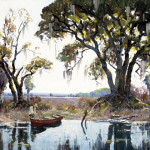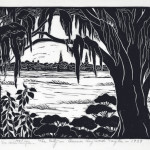Charleston, South Carolina has long been a tourist destination for those seeking warm weather, picturesque landscape, and the charm of a historic city. Artists are no exception to the rule, and a number of well-known names have visited the city and translated their experiences into works of art. Included among this group are such twentieth-century masters as Edward Hopper, Childe Hassam, George Biddle, and the photographer Walker Evans. Between the years of 1910 to 1945 in particular, Charleston flourished as a Mecca for artists, a period described today as the Charleston Renaissance.
The Charleston Renaissance was largely the result of a small community of resident artists who discovered in Charleston’s timeworn alleyways and weathered facades a visual beauty that spoke of an extraordinary architectural and cultural past. Centered on the work of Alice Ravenel Huger Smith, Anna Heyward Taylor, and Elizabeth O’Neill Verner, this time period engendered civic pride among Charlestonians and brought national attention to the rich cultural and architectural heritage of the city.
In many cases, the extent of interaction between the resident and visiting artists in Charleston during this time period is unclear. However, artists from each group depicted similar subject matter, and a sharing of subject matter suggests a sharing of ideas. Like the local artists, many of the artists who made shorter stays were captivated with the architecture of Charleston. Childe Hassam, Colin Campell Cooper, and Walker Evans all created work featuring the city’s structures. Edward Hopper focused on atmospheric impressions of the architecture and surrounding landscape. Artists such as Anthony Thieme captured the surrounding Lowcountry marshlands, while New York artists George Biddle and Palmer Schoppe turned their attention to the African-American inhabitants of the city. These artists are part of a long tradition of cultural exchange in Charleston, a tradition that remains very much alive today.
—Sara Arnold, Curator of Collections, Gibbes Museum of Art, and Pamela Wall, Curator of Exhibitions, Gibbes Museum of Art
Excerpted from Antiques & Fine Art, Volume X, Issue 6. To read the full article, please visit AFANews.com.
Published February 18, 2011







